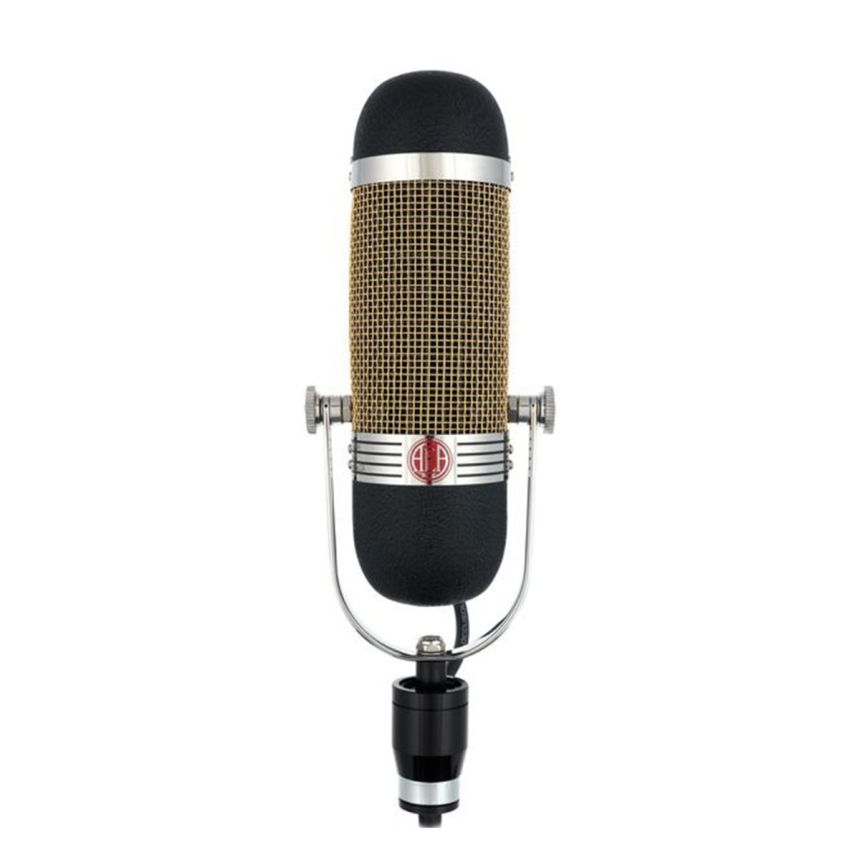AEA R84A
Powered Version of a Classic Ribbon Favorite
The exciting R84A is a powered version of AEA's acclaimed R84 microphone. Now, you can get that luscious ribbon sound, only with the benefit of a hotter signal that gives you a lot more versatility — in terms of how you use it, and what preamplifier you use it with. With an outstanding clear, natural sound, the R84A is going to become your first-call pick on a number of sources — from vocals to brass instruments to strings, piano, percussion, and beyond. When you're wanting that big, velvety ribbon sound, you won't believe your ears when you hear the AEA R84A.
What the A84A can do for you
If you regularly encounter harsh-sounding or overly bright sources, the AEA R84A is your new best friend. It works wonders, smoothing out and taming overly bright cymbals, shrill horns, and sibilant singers. Kicking in around one foot from the source, the R84A's proximity effect is less pronounced than the acclaimed A440's, so you can get in close on guitar cabs and use it on vocalists with a penchant for hugging the mic. The R84A uses the same ribbon and transformer as the A440, and it delivers the same huge, award-winning sound — with just a bit more top end, which is a good thing. Whether your recording tasks include massive-sounding drums or a symphony orchestra, the R84A will do you proud.
Big ribbon = big sound
Just like AEA's classic R44, the R84A employs AEA's 2-micron 2.35" x 0.185" low-tension, pure-aluminum ribbon element. Many ribbon mic manufacturers use shorter ribbons for ease of installation, but AEA’s Large Ribbon Geometry design delivers important advantages. A contrasted with condenser or moving-coil transducers, ribbon mics operate linearly above their resonant frequency, which implies that the resonant frequency of a superior microphone design should be as low as possible. And the longer the ribbon, the lower the resonant frequency. As the ribbon vibrates within the magnetic gap, it must move twice as far for every octave drop, hence a longer ribbon allows for further back-and-forth movement.
So far, we've established through physics that larger ribbons handle louder sound sources and higher sound pressure levels. AEA tunes most of their ribbons to 16.5Hz, and as the R84A shares the same Big Ribbon as the rest of the company's product range, it captures a smooth, natural, life-sized sound free of the resonance malfeasance that shorter ribbons and condensers may exhibit. The result is a true rendition of the source that engineers agree is remarkably close to what they hear when out in the tracking room.
Classic sound meets cutting-edge tech
Back in the day when RCA ruled the roost, ribbons microphones were, by definition, passive transducers. Along came the transistor and the accompanying miniaturization of electronic components, and it became possible to deploy ribbon mics in even more applications. In order to achieve optimal performance, a passive ribbon microphone needs to be matched with a high-impedance, high-gain preamp, such as AEA’s RPQ or TRP. But you can use active (phantom-powered) ribbon microphones like the R84 with a broader range of preamps, including those typically found, for instance, in USB audio interfaces. A Sweetwater tip is in order here: This does not mean that passive ribbon mics are an obsolete relics! Passive ribbons still beat out actives when it comes to maximum signal level (165dB vs. 141dB SPL), a minimalist signal path, and lower cash outlay.
World-class sonic performance and versatility
The R84A exhibits the same award-winning sonic prowess as its passive stablemate, the R84. But thanks to its higher output and immunity to impedance loading, it eliminates low-signal-level noise issues and gives you more flexibility in your choice of preamps. The R84A rectifies most of the limitations of passive ribbon mics, whether in an orchestral setting, in remote recording applications with long cable runs, or simply when combining the smooth sound of a ribbon with a low-gain vintage preamp. Bolstered by the signal strength and versatility of its active JFET electronics combined with the posh warmth of AEA's Big Ribbon, the R84A is a must-have for any well-equipped studio. And owning a pair of them vastly increases the versatility of this outstanding microphone, opening up highly effective stereo recording techniques such as Blumlein.
AEA R84A Powered Ribbon Microphone Features:
- Phantom powered (48V) version of AEA's classic R84 with 12dB more sensitivity
- Same award-winning sound as the passive R84
- Large-diaphragm ribbon microphone
- Well-controlled, native figure-8 polar pattern
- Compatible with any preamp and input impedance
- Fast, accurate transient reproduction
- Custom German toroidal transformer and JFET electronics
- Wide-band 20Hz–20kHz frequency response
- High SPL capability of 141dB
- Low self-noise of 17.5dB(A)







